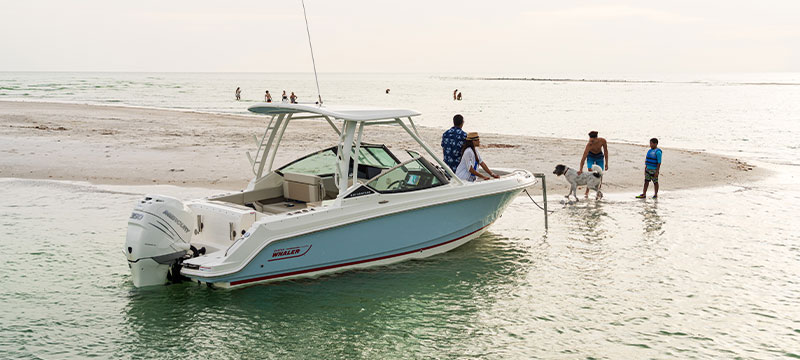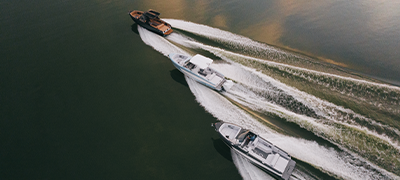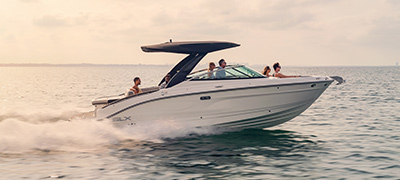2 Stroke Versus 4 Stroke Outboard Boat Motor Comparison
There has been a divide between those that prefer 2-stroke outboards and those who prefer 4-stroke outboards. Traditionally, because of the simplicity and lightweight, 2-stroke outboards have dominated the outboard market. It is widely understood that modern 4-stroke outboards are quieter, produce less vibration, and create significantly less pollution. However, until recently, due to expense and weight, 4-stroke outboards were not widely accepted. Here at MarineMax, we offer both 2-stoke and 4-stroke outboards that you can view in our inventory.
How the Outboard Engine Evolved
In 2004, the Environmental Protection Agency (EPA) put an end to the 2-stroke's dominance by enacting stricter limits on pollutants, and then in 2007, making the restrictions even stricter. It became evident that it would be necessary for the 2-stroke outboards to be re-engineered to become quieter and cleaner running. In turn, in order to compete with the 2-stroke performance, 4-stroke outboards needed to lose some weight.
Although the American Motors Company made about 25 gas-powered outboards before 1900, it took a Yale engineering student named Cameron Waterman to make a commercially feasible outboard. Waterman started developing the “Porto-Motor” in 1903. By 1914, the company had sold over 25,000 units.
The best known and most successful early outboard motor was developed by a Norwegian immigrant inventor, Ole Evinrude, in 1909. By 1912, the Evinrude Outboard Company had sold thousands. Ole Evinrude sold out to his partner in 1913 with a promise not to compete for 5-years. In 1920, Ole and his wife, Bess, founded the ELTO (Evinrude Light Twin Outboard) company and introduced a lightweight 2-cylinder outboard. Eventually, due to declining markets, ELTO, Evinrude, and the Lockwood Motor Company would merge to become OMC (Outboards Motor Corporation) later acquiring Johnson Motors Co. in 1935.
By the 1940’s, there were dozens of outboard motor companies manufacturing mainly 2-stroke outboard motors. Although there were some 4-stroke outboards being manufactured, it was not until 1962 that Homelite introduced a commercially successful 55 horsepower 4-stroke outboard motor. Dubbed the Bearcat, the company was later purchased by Fischer-Pierce, the makers of the unsinkable fiberglass and foam Boston Whaler.
Maintaining an Outboard Engine
Today, manufacturers like Mercury Marine have developed 4-stroke outboards that weigh and perform comparably with 2-stroke outboards. And by using direct injection techniques, Mercury Marine is also making 2-stroke outboards that are as clean running, smooth and quiet as 4-stroke outboards.
Which engine is best for you? It really comes down to how the cylinders are lubricated. 4-stroke outboards have internal oil reservoirs and sumps which need regular oil level checks, filter replacements and oil changes at least annually. 2-stroke outboards generally have an external oil tank with the oil and fuel mixture injected into the cylinder. The oil is consumed and the oil tank level must be maintained, replacing oil as it is used up.
Any way you look at it, this is one example of the EPA enacting an ordinance that clearly benefits the consumer and the environment. And now, there are new alternatives on the horizon with companies like Torqueedo and Elco making electric outboards. Today and into the future, 2-stroke, 4-stroke, electric or diesel, the choice is all yours.
How They Work
We have already mentioned some of the unique qualities of each type of these outboard engines, so here is the “why”. Exactly why these two engines are different comes down to what’s happening on the inside.
In a 4-stroke outboard, the piston needs four movements (strokes) in order to complete a cycle – intake, compression, combustion and exhaust. Conversely, a 2-stoke only needs two movements of the piston to complete the same action.
It is for this reason that 2-strokes are smaller, lighter and less complex than 4-strokes, they simply have fewer moving parts. This is where the 2-stroke’s power advantage comes from, however they are less eco friendly because they produce higher emissions commensurate with their more simplistic nature.

Find Your Perfect Boat Today

Boat Types

